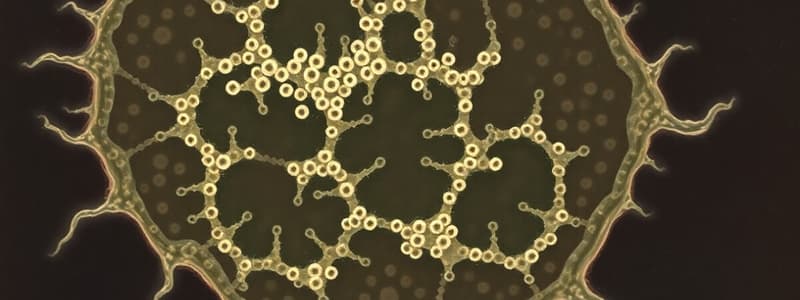Podcast
Questions and Answers
What term is used to describe bacteria due to their lack of a true nucleus?
What term is used to describe bacteria due to their lack of a true nucleus?
- Archaea
- Eukaryotes
- Prokaryotes (correct)
- Multicellular organisms
Which of the following components is present in eukaryotic cells but absent in bacteria?
Which of the following components is present in eukaryotic cells but absent in bacteria?
- Mitochondria (correct)
- Flagella
- Cell wall
- Ribosomes
What type of ribosome is found in bacterial cells?
What type of ribosome is found in bacterial cells?
- 80S ribosomes
- 60S ribosomes
- 100S ribosomes
- 70S ribosomes (correct)
Which component of bacteria provides structural support?
Which component of bacteria provides structural support?
Which was Anton van Leeuwenhoek known for discovering?
Which was Anton van Leeuwenhoek known for discovering?
What describes the genetic material in bacterial cells?
What describes the genetic material in bacterial cells?
What is the primary function of pili or fimbriae in bacteria?
What is the primary function of pili or fimbriae in bacteria?
Which type of flagellar motion is typical in prokaryotic bacteria?
Which type of flagellar motion is typical in prokaryotic bacteria?
What structure characterizes the bacterial genome?
What structure characterizes the bacterial genome?
Which of the following correctly describes plasmids?
Which of the following correctly describes plasmids?
How do transient organisms differ from resident microbiota?
How do transient organisms differ from resident microbiota?
Which component is associated with Gram-negative bacteria?
Which component is associated with Gram-negative bacteria?
What is the role of insertion sequences (IS) in bacteria?
What is the role of insertion sequences (IS) in bacteria?
What defines an acute carrier in the context of microbial biota?
What defines an acute carrier in the context of microbial biota?
Which process do bacteria use for energy generation?
Which process do bacteria use for energy generation?
Which of the following accurately describes resident microbiota?
Which of the following accurately describes resident microbiota?
Which of the following disinfectants is primarily used for disinfecting instruments and remains active against a broad spectrum of pathogens?
Which of the following disinfectants is primarily used for disinfecting instruments and remains active against a broad spectrum of pathogens?
Which mechanism is associated with the action of Alcohols as disinfectants?
Which mechanism is associated with the action of Alcohols as disinfectants?
What is a significant limitation of using Aldehydes as disinfectants?
What is a significant limitation of using Aldehydes as disinfectants?
Iodophors are known for their effectiveness as disinfectants when which condition is met?
Iodophors are known for their effectiveness as disinfectants when which condition is met?
What percentage of a bacterium's dry weight is accounted for by carbon?
What percentage of a bacterium's dry weight is accounted for by carbon?
What is the main action of Chlorhexidine Gluconate in antisepsis?
What is the main action of Chlorhexidine Gluconate in antisepsis?
Which type of disinfectant contains modified phenol molecules enhanced with halogens or alkyl groups?
Which type of disinfectant contains modified phenol molecules enhanced with halogens or alkyl groups?
Which dye is used to visualize fungal structures by binding to the cell wall chitin?
Which dye is used to visualize fungal structures by binding to the cell wall chitin?
Which group of bacteria can grow using carbon dioxide as their sole carbon source?
Which group of bacteria can grow using carbon dioxide as their sole carbon source?
What is one primary regulatory consideration for disinfectants and antiseptics?
What is one primary regulatory consideration for disinfectants and antiseptics?
What limitation affects the effectiveness of Quaternary Ammonium Compounds?
What limitation affects the effectiveness of Quaternary Ammonium Compounds?
What is the main energy source required for ATP production in bacteria?
What is the main energy source required for ATP production in bacteria?
What type of bacteria requires oxygen to survive?
What type of bacteria requires oxygen to survive?
Which dye primarily stains Corynebacterium diphtheriae?
Which dye primarily stains Corynebacterium diphtheriae?
What role do smaller amounts of phosphorus, sulfur, and metal ions play in bacteria?
What role do smaller amounts of phosphorus, sulfur, and metal ions play in bacteria?
What temperature range do thermophiles typically thrive in?
What temperature range do thermophiles typically thrive in?
What is a key reason for the limited use of certain gaseous disinfectants?
What is a key reason for the limited use of certain gaseous disinfectants?
What must preoperative skin preparation primarily achieve?
What must preoperative skin preparation primarily achieve?
Which disinfectant is noted for requiring careful control of temperature, humidity, and concentration?
Which disinfectant is noted for requiring careful control of temperature, humidity, and concentration?
What was a common laboratory behavior prior to the 1980s that posed safety risks?
What was a common laboratory behavior prior to the 1980s that posed safety risks?
What prompted a significant re-evaluation of laboratory safety protocols during the AIDS crisis?
What prompted a significant re-evaluation of laboratory safety protocols during the AIDS crisis?
What advantage does combining hydrogen peroxide and peracetic acid offer over using them individually?
What advantage does combining hydrogen peroxide and peracetic acid offer over using them individually?
What aspect of laboratory culture changed significantly after the awareness of biological hazards increased?
What aspect of laboratory culture changed significantly after the awareness of biological hazards increased?
What type of microorganisms is hydrogen peroxide effective against?
What type of microorganisms is hydrogen peroxide effective against?
Flashcards are hidden until you start studying
Study Notes
History of Microbiology
- Anton van Leeuwenhoek is recognized as the “father of protozoology and bacteriology.”
- He discovered microorganisms, calling them "wee beasties" or "animalcules," using a homemade microscope.
- His work confirmed the existence of many microbes, most of which do not cause disease.
Bacteria: Overview and Structure
- Bacteria are unicellular prokaryotes, lacking a true nucleus and membrane-bound organelles like mitochondria and ER.
- Genetic material consists of circular, supercoiled double-stranded DNA, which is simpler than eukaryotic linear DNA located in a nucleus.
- Bacteria possess unique ribosomes (70S) and cell walls made of peptidoglycan, differing from the eukaryotic (80S) ribosomes and plant cell walls composed of cellulose.
Bacterial Genome and Genetic Material
- Bacterial genomes include genes for protein coding and regulatory regions for transcription control.
- Plasmids are small, circular DNA that can replicate independently; they may carry genes for antimicrobial resistance.
- Gram-negative bacteria often contain lipopolysaccharides (LPS) that can induce fever and shock.
Microbial Biota and Colonization
- Microorganisms can be classified as resident microbiota (long-term colonizers) or transient microbiota (temporary inhabitants).
- Acute carriers are transient carriers harboring specific pathogens during outbreaks.
Nutritional Requirements for Bacteria
- Bacteria are classified into autotrophs (which use carbon dioxide as a carbon source) and heterotrophs (which require complex organic substances).
- Essential nutrients include carbon (approx. 50% of dry weight), nitrogen (14% for proteins and nucleic acids), and smaller amounts of phosphorus and sulfur for enzymatic functions.
Common Stains and Visualization Techniques
- Calcofluor White is used to visualize fungal structures by binding to chitin in fungal cell walls.
- Methylene Blue stains certain bacteria and is used in acid-fast staining.
- Lactophenol Cotton Blue is used for observing fungal morphology.
Disinfectants and Antiseptics
- Alcohols are effective against most bacteria and some viruses, primarily used as antiseptics.
- Aldehydes like glutaraldehyde are high-level disinfectants, though limited by organic matter interference.
- Phenolics, modified phenol molecules, disrupt cell walls and precipitate proteins.
Regulatory and Safety Considerations
- Disinfectants undergo regulatory processes to ensure safety and efficacy.
- Guidelines emphasize adherence to manufacturer instructions to prevent infection.
- Chlorhexidine Gluconate is effective for topical antisepsis despite some toxicity.
Gaseous Disinfectants and Sterilization
- Ethylene Oxide is used for sterilization but requires careful control of concentration and environment.
- Hydrogen Peroxide is active against all microorganism types and is utilized in vapor form for sterilization.
- Peracetic Acid serves as an effective sterilant in its gaseous form.
Shift in Safety Culture
- The advent of AIDS prompted reevaluation of laboratory safety protocols and awareness of biological hazards.
- Historical lax safety practices led to improvements in laboratory protocols including the cessation of risky behaviors.
Studying That Suits You
Use AI to generate personalized quizzes and flashcards to suit your learning preferences.




